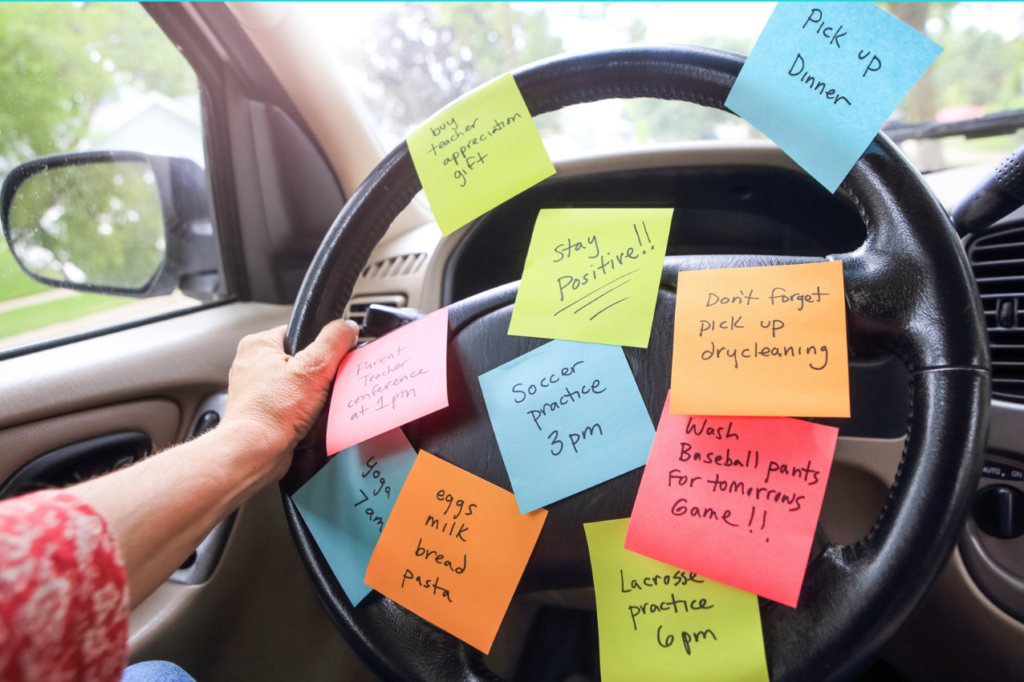I have noticed that many of my clients struggle with the executive function skill of prioritization.
As they move through the day, they get stuck deciding what is the most important thing to do right now. They may have a to-do list that overwhelms them. Some freeze and end up accomplishing nothing.
Others find themselves victims of the urgency effect. They do what is immediately in front of them, bouncing from task to task as something new enters their field of view. In this scenario, they don’t achieve the tasks that they know are really important. They feel frustrated and inefficient. In both situations, making a decision for the next “best” action is too much for their brain to handle.
How to Take Back Control of Your Executive Functions

First, feel your feet. Notice how the floor feels sturdy beneath them. Feel those wonderful, loyal feet supporting you. By pressing into your feet, you redirect your brain away from your emotional center and toward your sensory system, allowing the prefrontal cortex – the part of your brain that controls your purposeful executive functions – to take back control.
Then, take a couple of deep breaths. For me, breathing deeply is like pushing a reset button on my computer.
Now, with a calmed brain, you can actually think and use your wise prefrontal cortex to make a choice for your next action. Pause and use metacognition, which means thinking about your thinking. As you face your choice, remember that your emotional brain has the power to dominate your wise prefrontal cortex. You must tell that emotional brain to COOL ITS JETS for a moment, while you answer this question:
Which choice will be better for my “future” me? For instance, will the choice I make NOW end up making me late to an appointment, meeting, picking up the kids, or going to bed on time?
Here’s what that conversation might look like.
Prefrontal Cortex: I should finish writing up those meeting notes before I forget them.
Emotional Brain: But that meeting was LONG and I have so much to do!
Prefrontal Cortex: Finish them now. Just a few minutes now means that you won’t feel incompetent later when you might leave something out because you forgot about it. You won’t have to make any excuses.
Choose to be kind to your future self.
 Listening to your prefrontal cortex might also mean STOPPING yourself from over-prioritizing the value of a task. Over-prioritization is common for those who experience hyperfocus, often a side affect of ADD/ADHD.
Listening to your prefrontal cortex might also mean STOPPING yourself from over-prioritizing the value of a task. Over-prioritization is common for those who experience hyperfocus, often a side affect of ADD/ADHD.
For example, the other evening I surprised myself by clearing out my kitchen baking drawer that is full of containers of different flours, grains, sugars and salts. First, I mercilessly trashed anything I couldn’t remember purchasing (undoubtedly out of date). After vacuuming the drawer I even washed all the containers.
When I was done, I had a few empty ones that were too damp to refill before I went to bed. The next morning before work, I found myself in the basement pantry looking for paper towels needed in the kitchen. Grabbing the towels, my eyes fell upon a new bag of bread flour and a bag of sugar. “Oh! I can just grab these two bags and fill those empty containers.” My emotional brain got all excited about doing the next steps to finish organizing that drawer.
Suddenly, up popped the voice of my dear prefrontal cortex which said: “Oh, no you don’t. Now is NOT the time to finish that project. You have to get to the office to be ready for the staff meeting.” My prefrontal cortex knew the best choice. I just had to listen to it and I did. I avoided having to apologize to my staff for being late since we had made a commitment to be ready on time.
Yes, I had to use another executive function skill – self-control – but that night I did refill those containers. Even though I had to delay the gratification of completion, I still got a wonderful feeling when I was done.
What to Prioritize on a Long To-Do List?
The challenge of choosing what task to focus on is especially common in work settings.
You know the feeling: you walk out of a meeting and suddenly your to-do list is much longer then when you went in. Your emotional brain kicks into overwhelm. The stress hormone, cortisol, shoots into your brain. It ALL looks critical and you freeze. Which project is the most important to do first?
In this case, feel your feet, take a deep breath and reach out to your supervisor to set up a meeting. Explain that you need some input from them to help you prioritize your next actions. Your supervisor will have a different knowledge set and perspective on priorities than you might. Since they are the person you need to please, get their input. Plus, sitting down and sharing your to-do list will give them a better understanding of your workload and an appreciation for all that you do. The list won’t go away, but you’ll feel better knowing where to start.
My daughter had been feeling behind and overwhelmed at work. Once she checked in with her supervisor for help with prioritizing, she texted me: “I feel a bit better. Not so crazy.” That was a step in the right direction!
To summarize, if you find yourself struggling with prioritization go through these steps:
1. Calm your brain to give the prefrontal cortex control. Your emotional brain rarely makes the best choice when it comes to task completion.
2. Answer the question: Which choice is best for my future self? Avoid a choice that will set up conflict or pain in the future.
3. Get help: If you just can’t choose the next step from a long to-do list, get some help prioritizing it. This is something I do all the time with clients in my Seeing My Time course.
Little by little…we learn to make better choices.
Marydee


Aloha Mary Dee! What a great article on the pre-frontal activation technique. Thank you for this. How I wished I read this in June as we were in the middle of shifting places, consolidating our belongings and preparing to leave the mainland for a new chapter in life! Alas, after several shifts in lodging, we are now settled in a small plantation house (built in 1919) located in the hamlet of O’okala on the Big Island. Keep up your wonder- ful work. I will definitely use the technique as we return to Pdx next week to DOWNSIZE our storage unit. “When in doubt, throw it out!”- I’m starting to practice this too:).
Daria, Thank you! And your retirement home sounds absolutely wonderful! Congratulations. And you will get through that storage, little by little… Read Marie Kondo (if you haven’t) for some inspiration. My daughter and boyfriend went completely through their one-bedroom and it was a miracle! So, I have been inspired too. I took a carload of stuff to Goodwill today!